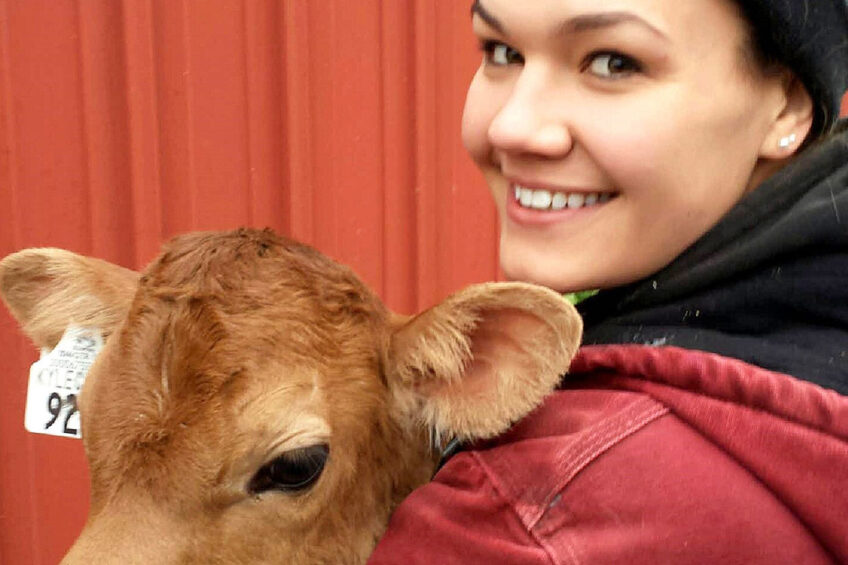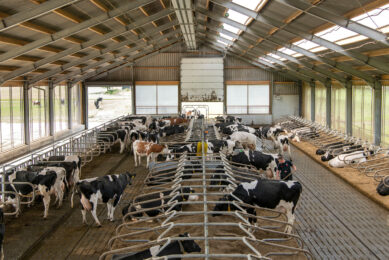Farm report US: Preparing to take over the family dairy farm

Anna Hinchley knew from an early age that she was destined to take over the running of her family’s dairy farm in Wisconsin, USA, and has returned home after college to do exactly that.
Based just outside the small town of Cambridge, Hinchley’s dairy farm is home to 240 Holstein cows milked via 4 Lely robots, which is a huge step into modern farming compared to when Anna’s grandparents first purchased it.
Now Anna, 25, has just got married and is taking on a bigger role of running the farm with her parents.
She recently got married on the farm!
PROFILE
Name: Anna Hinchley
Location: Near Cambridge, Wisconsin
Cows: Hinchley’s dairy farm has 240 Holstein cows milked via 4 Lely robots
Milk: The milk produced from milked cows have 3.65% butterfat and 2.96% protein
Anna says, “My grandparents, Keith and Ruth Hinchley, purchased the farm in 1958 comprising of 140 acres with a 38 head tie stall barn and several outbuilding for pigs and chickens. The buildings have been expanded and today we are milking 240 cows using Lely A5 robots, and growing crops on 2,300 acres.
I knew early on that I wanted to farm with my parents.”
“I grew up on the farm, so I naturally was involved with feeding calves and taking care of the barn yard animals at a very young age. As I grew my responsibilities grew too and I am now farming alongside my parents Tina and Duane full time.
“I knew early on that I wanted to farm with my parents, so I went to the University of Wisconsin, Madison. Currently my parents own the farm and I am receiving 3% of the milk cheque. Together, we are working on a transition plan to slowly ease me into owning a share of the farm.”
Each cow can visit the robots on the Hinchley farm up to 6 times per day. The current average is 3 times daily producing an average of 89 pounds of milk at 3.65% butterfat and 2.96% protein. All the replacement heifers are raised on the farm accounting for over 300 head.
“All our cows are fed a TMR (Total Mixed Ration) that consists of BMR (Brown Mid-Ribbed) corn silage and alfalfa, both of which are fermented in bunker silos. Also, in the ration there are vitamins and minerals and at times cotton seed if needed. These crops are grown, harvested and stored on our farm to be mixed twice daily.
“We use a 620 cubic feet Patz mixer that uses twin screw augers to feed the cows. There are different rations for the heifers, dry cows, and milk cows.
“All the cattle we own are split into groups starting at weaning and advancing every 2 months into the next groups. We start breeding at 12 to 14 months of age using AI. The bred heifers are kept separate from the dry cows and are then moved into the robot facility 2 weeks before calving to allow them to acclimatise to the new barn. Milking heifers are separated from the milk cows on each side of the barn with the feed alley in the middle,” she adds.

Due to Covid-19 the Hinchleys have reduced their staff numbers to just 2 part-time workers alongside the three family members. The pandemic has also affected milk prices recently which have been very volatile averaging US$15 per cwt, or $1.29 per gallon, or US$0.35 (UK£0.27) per litre. “Our milk is sold through DFA, Dairy Farmers of America which is the largest dairy cooperative in the United States,” she says.
Our farm will be more sustainable if we are not spreading manure daily.”
Modernising technology
In terms of technology, the Hinchley farm has been well modernised with the addition of the robots but there are other new features too.
“Our new 127ft x 330ft dairy barn has been designed to have the best environment for cows to have a healthy, productive life, while being able to make choices when to be milked, where to lie down, and when they want to eat,” says Anna. “It is insulated and has Plexy-glass panels on the top of the building let natural sunlight into the barn.”

“Our research concludes that our farm will be more sustainable if we are not spreading manure daily, so below the building is a 12 foot deep storage system for holding manure so it can be used in the fall to enrich our soil with the nutrients.
“This is a modern slatted floor barn that has rubber mats over the slats and sites for the stirring pumps and easy access for the removal. 2 Lely Discovery robots push manure through the slatted floor on routes throughout the day to keep the floors clean and dry.
“The purchase of the 4 Lely robot milking systems has given us the opportunity to focus on only the cows that need attention. This milking system is monitoring every cow at every milking taking in over 110 data points. We are watching for cow’s milk temperature, milk volume, conductivity, and protein/butterfat ratios.”

“Thinking about cow comfort and the impacts on our robots and environment, we chose Dual Chamber Comfort (DCC) waterbeds for the cows to lie on. Bedding on the top with recycled pallets keeps the cows clean with minimal daily maintenance.
“Also, the east and west ends of the barn have tunnel ventilation with velocity fans which are positive pressure fans to control the air flow and fogging system to cool on extremely hot days.
“Understanding that cows need feed 24 hours a day, we invested in 2 Lely Juno robots that push feed up every 2 hours,” she says.
Investment into the business
The farm was expanded in preparation for Anna’s return from college and she has already made her first investment into the business.
“I recently made my first capital investment into the farm and purchased a CF1000+ calf feeding system,” she explained. “This is a robotic milk feeding system that will allow the calves to drink milk replacer on demand. The system will monitor each calf and will ease them to weaning with a better rate of gain, getting the calves onto feed, and creating a better cow in the future.”
On top of milking cows the Hinchley farm has been hosting farm tours for over 25 years, educating students, families, and international visitors. Even during the Covid-19 era the tours continue.

“We are currently giving tours on Tuesdays, Thursdays, and Sundays 3 times a day. There is so much demand right now. Many other attractions are closed but farms are always operating so people are flocking to us.”
Anna knows she will face many more challenges as a dairy farmer, particularly so in her area.
“In Wisconsin we have many dairy farms, all different sizes. Everyone can have the best genetics and great feed for their animals, and at times we have a milk surplus. The extra milk in the supply causes milk prices to drop and dairy farming has become a struggle to many farmers. Annually we lose many dairy farms due to retirement, but lately it has been due to lack of income because of low milk prices.
“My family has diversified in the past by also growing other crops to sell. Being able to cash crop while running a dairy farm has helped us overcome the hard times,” she said.
Join 13,000+ subscribers
Subscribe to our newsletter to stay updated about all the need-to-know content in the dairy sector, two times a week.










